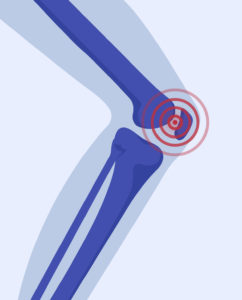Chiropractic Treatment of Chondromalacia Patellae
How can we tell if the pain is Chondromalacia Patellae?
Chondromalacia Patellae (also known as Patellofemoral Arthralgia) causes pain at the front of the kneecap (the patella) which can make it difficult to straighten the leg. The pain will be worse when going up and down stairs and after sitting for long periods of time. There can be a crackling, grating, or popping sound (or sensation) when bending the knee or squatting.
Why do we get Chondromalacia Patellae?
Chondromalacia Patellae occurs with repetitive activities that put stress on the knees. When there is constant stress on the knees, the muscles that surround the patellae become imbalanced (some too weak and others too tight) which causes the patellae to misalign. When the patellae is misaligned, the knee joint weakens, which leads to inflammation, tenderness or pain, and decreased range of motion. Repetitive activities such as lifting heavy weights with improper form/posture, running, jumping, and sitting for long periods of time can cause and exacerbate this disorder.
How does Chiropractic help individuals recover from Chondromalacia Patellae?
When the knee joint is out of alignment, it can irritate surrounding ligaments, tendons, muscles, and nerves. Your chiropractor will assess the knee and determine if a specific adjustment is needed. They will also evaluate the muscular balance around the knee and recommend stretches and exercises to restore balance.
Additionally, your chiropractor will examine the spinal segments of the lower back and pelvis. Misalignments in these areas can create imbalances in the muscles and nerves of the knee, potentially contributing to Chondromalacia Patellae. If any misalignments are found, your chiropractor will correct them with a gentle adjustment.
How do individuals recover from Chondromalacia Patellae?
The first step to recovery is to be evaluated and if needed, adjusted by your chiropractor. After this, your chiropractor will show you exercises and stretches to balance the muscles that surround and protect your knees and help the joint to stabilize.
Stretches and strengthening for Chondromalacia Patellae
It is important to stretch the quadriceps and Tensor Fasciae Latae (TFL) muscles to help balance the knee. Be sure to stretch both sides but focus more on the affected side. Videos are forthcoming.
